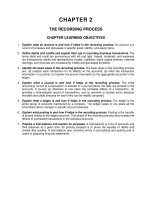Financial accounting IFRS 4 kieoso ch08 PPT
Bạn đang xem bản rút gọn của tài liệu. Xem và tải ngay bản đầy đủ của tài liệu tại đây (356.79 KB, 70 trang )
Financial Accounting
IFRS 4th Edition
Weygandt ● Kimmel ● Kieso
Chapter 8
Accounting for Receivables
Chapter Outline:
Learning Objectives
LO 1 Explain how companies recognize accounts
receivable.
LO 2 Describe how companies value accounts receivable
and record their disposition.
LO 3 Explain how companies recognize, value, and
dispose of notes receivable.
LO 4 Describe the statement presentation and analysis
of receivables.
Copyright ©2019 John Wiley & Sons, Inc.
2
Learning Objective 1
Explain How Companies Recognize
Accounts Receivable
Copyright ©2019 John Wiley & Sons, Inc.
3
Recognition of Accounts Receivables (1 of 2)
• The term receivables refers to amounts due from
individuals and companies
• Receivables are claims that are expected to be
collected in cash
• Management of receivables is a very important
activity for any company that sells goods or services
on credit
• Receivables are important because they represent
one of a company’s most liquid assets
Copyright ©2019 John Wiley & Sons, Inc.
4
Recognition of Accounts Receivables (2 of 2)
Amounts due from individuals and companies that are expected to
be collected in cash.
Company
Adidas (DEU)
Hyundai (KOR)
Samsung (KOR)
Nestlé (CHE)
China Mobile Limited (HKG)
Receivables as a Company
Percentage of Total Assets
16%
5
13
41
2
Copyright ©2019 John Wiley & Sons, Inc.
5
Types of Receivables (1 of 2)
Amounts due from individuals and companies that are expected to
be collected in cash.
Amounts customers
owe on account that
result from the sale
of goods and
services.
Accounts
Receivable
Written promise
(formal instrument)
for amount to be
received. Normally
requires the
collection of
interest.
Notes
Receivable
Copyright ©2019 John Wiley & Sons, Inc.
Nontrade receivables
such as interest,
loans to officers,
advances to
employees, and
income taxes
refundable.
Other
Receivables
6
Recognizing Accounts Receivable (1 of 5)
• Service organization records a receivable when it
performs service on account
• Merchandiser records accounts receivable at point of
sale of merchandise on account
• Seller may offer a discount to encourage early
payment
• Buyer might return goods found to be unacceptable
Sales returns reduce receivables
Copyright ©2019 John Wiley & Sons, Inc.
7
Recognizing Accounts Receivable (2 of 5)
Illustration: Assume that Zhang Ltd. on July 1, 2020, sells
merchandise on account to Li Stores for ¥1,000, terms 2/10,
n/30 (amounts in thousands). On July 5, Li returns
merchandise with a sales price of ¥100 to Zhang. Prepare the
journal entries to record these transactions.
Jul. 1
Jul. 5
Accounts Receivable
Sales Revenue
Sales Returns and Allowances
Accounts Receivable
Copyright ©2019 John Wiley & Sons, Inc.
1,000
1,000
100
100
8
Recognizing Accounts Receivable (3 of 5)
Illustration: On July 11, Zhang receives payment from Li for
the balance due. Prepare the journal entry to record this
transaction.
Jul. 11
Cash (¥900 − ¥18)
Sales Discounts (¥900 x .02)
Accounts Receivable
Copyright ©2019 John Wiley & Sons, Inc.
882
18
900
9
Recognizing Accounts Receivable (4 of 5)
Illustration: Some retailers issue their own credit cards. When
you use a retailer’s credit card (IKEA, for example), the retailer
charges interest on the balance due if not paid within a
specified period (usually 25–30 days).
Illustration: Assume you use your IKEA credit card to purchase
clothing with a sales price of €300 on June 1, 2020. The entry
is recorded as follows.
Jun. 1
Accounts Receivable
Sales Revenue
Copyright ©2019 John Wiley & Sons, Inc.
300
300
10
Recognizing Accounts Receivable (5 of 5)
Illustration: Assuming that you owe €300 at the end of the
month and IKEA charges 1.5% per month on the balance due,
the adjusting entry that IKEA makes to record interest revenue
of €4.50 (€300 × 1.5%) on June 30 is as follows.
June 30 Accounts Receivable
Interest Revenue
Copyright ©2019 John Wiley & Sons, Inc.
4.50
4.50
11
Do It! 1: Recognizing Accounts
Receivable (1 of 3)
On May 1, Wilton sold merchandise on account to Bates for
£50,000, terms 3/15, net 45. On May 4, Bates returns merchandise
with a sales price of £2,000. On May 16, Wilton receives payment
from Bates for the balance due. Prepare journal entries to record
the May transactions on Wilton’s books. (Ignore cost of goods sold
entries.)
May 1
Accounts Receivable
Sales Revenue
Copyright ©2019 John Wiley & Sons, Inc.
50,000
50,000
12
Do It! 1: Recognizing Accounts
Receivable (2 of 3)
On May 1, Wilton sold merchandise on account to Bates for
£50,000, terms 3/15, net 45. On May 4, Bates returns merchandise
with a sales price of £2,000. On May 16, Wilton receives payment
from Bates for the balance due. Prepare journal entries to record
the May transactions on Wilton’s books. (Ignore cost of goods sold
entries.)
May 4
Sales Returns and Allowances
Accounts Receivable
Copyright ©2019 John Wiley & Sons, Inc.
2,000
2,000
13
Do It! 1: Recognizing Accounts
Receivable (3 of 3)
On May 1, Wilton sold merchandise on account to Bates for
£50,000, terms 3/15, net 45. On May 4, Bates returns merchandise
with a sales price of £2,000. On May 16, Wilton receives payment
from Bates for the balance due. Prepare journal entries to record
the May transactions on Wilton’s books. (Ignore cost of goods sold
entries.)
May 16
Cash (Ê48,000 Ê1,440)
Sales Discounts (Ê48,000 ì .03)
Accounts Receivable
Copyright â2019 John Wiley & Sons, Inc.
46,560
1,440
48,000
14
Learning Objective 2
Describe How Companies Value
Accounts Receivable and Record Their
Disposition
Copyright ©2019 John Wiley & Sons, Inc.
15
Valuation of Accounts Receivable
Valuing Accounts Receivable
• Current asset
• Valuation (net realizable value)
Uncollectible Accounts Receivable
• Sales on account raise possibility of accounts not
being collected
• Seller records losses that result from extending
credit as Bad Debt Expense
Copyright ©2019 John Wiley & Sons, Inc.
16
Accounting for Uncollectible Accounts
Direct Write-Off Method
• No matching of expenses with revenues
• Receivable not stated at net realizable value
• Not acceptable for financial reporting purposes
Allowance Method
• Better matching of expenses with revenues
• Receivable stated at cash (net) realizable value
• Required for financial reporting purposes
Copyright ©2019 John Wiley & Sons, Inc.
17
Valuing Accounts Receivable
How are these accounts presented on the Balance Sheet?
Accounts Receivable
Bal.
200,000
Allowance for
Doubtful Accounts
12,000
Bal.
Bal.
Bal.
Copyright ©2019 John Wiley & Son, Inc.
18
Valuing Accounts Receivable
Hampson Furniture
Statement of Financial Position (partial)
Current Assets
Supplies
Inventory
Accounts receivable
Less: Allowance for doubtful accounts
Cash
Total current assets
LO 2
Copyright ©2019 John Wiley & Son, Inc.
€ 25,000
310,000
€200,000
12,000
188,000
14,800
€537,800
19
Valuing Accounts Receivable
Hampson Furniture
Statement of Financial Position (partial)
Current Assets
Supplies
Inventory
Accounts receivable, net of €12,000 allowance
Cash
Total current assets
LO 2
Copyright ©2019 John Wiley & Son, Inc.
Alternate
Presentation
€ 25,000
310,000
188,000
14,800
€537,800
20
Valuing Accounts Receivable
Journal entry for credit sale of €100
Accounts Receivable
Sales Revenue
Accounts Receivable
Bal.
500
Sale
100
Bal.
LO 2
100
100
Allowance for
Doubtful Accounts
25
Bal.
600
25
Copyright ©2019 John Wiley & Son, Inc.
Bal.
21
Valuing Accounts Receivable
Collect €333 on account?
Cash
Accounts Receivable
Accounts Receivable
Bal.
500
Sale
100
333 Coll.
Bal.
LO 2
333
333
Allowance for
Doubtful Accounts
25
Bal.
267
25
Copyright ©2019 John Wiley & Son, Inc.
Bal.
22
Valuing Accounts Receivable
Adjustment of €15 for estimated bad debts?
Bad Debt Expense
Allowance for Doubtful Accounts
Accounts Receivable
Bal.
500
Sale
100
333 Coll.
Bal.
LO 2
15
15
Allowance for
Doubtful Accounts
25
Bal.
15
Exp.
267
40
Copyright ©2019 John Wiley & Son, Inc.
Bal.
23
Valuing Accounts Receivable
Write-off of uncollectible accounts of €10?
Allowance for Doubtful Accounts
Accounts Receivable
Accounts Receivable
Bal.
500
Sale
100
333 Coll.
10
w/o
Bal.
257
LO 2
10
10
Allowance for
Doubtful Accounts
25
Bal.
15
Exp.
w/o
10
30
Bal.
Copyright ©2019 John Wiley & Son, Inc.
24
Valuing Accounts Receivable
ABC Supplies
Statement of Financial Position (partial)
Current Assets
Prepaid expense
Inventory
Accounts receivable
Less: Allowance for doubtful accounts
Cash
Total current assets
LO 2
Copyright ©2019 John Wiley & Son, Inc.
€
€257
30
40
812
227
330
€1,409
25









